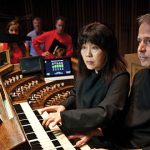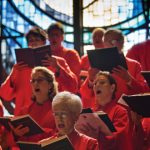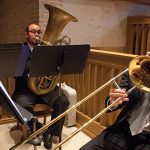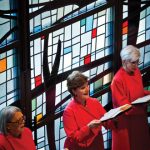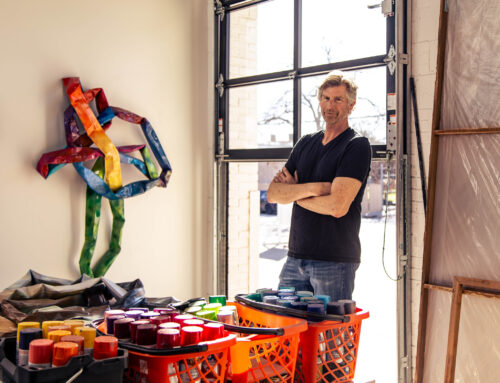Preston Hollow doesn’t have a music scene. Or maybe, you just have to know where to look. Our neighborhood churches and synagogues are home to some of the best performers around.

James Diaz, the director of music at St. Michael and All Angels Episcopal Church, plays the organ. Photo by Kim Leeson
Pipedreams
Every organ has its own personality. The one inside the main sanctuary at St. Michael and All Angels Episcopal Church, with 68 stops and 5,100 pipes that stretch toward the ceiling and frame the stained glass Creation Window, is suited for playing French romantic music.
“It has a particularly French accent to it,” says James Diaz, St. Michael’s organist and music director. “Organs tend to have a very distinct sound.”
[quote align=”right” color=”#000000″]“This is some of the best music in town. It’s like coming to a concert every week.”[/quote]That sound hasn’t lost its effect, especially in the church. At St. Michael, the choir and organ occupy the loft at the back of the sanctuary, almost completely out of the congregation’s sight, which “adds an element of mysticism,” Diaz says, as the music envelopes the room.
At the end of a patriotic service in June, before filing out of the sanctuary, guests stood up and turned around to watch Diaz and his wife, Hyeon Jeong, perform “Stars and Stripes Forever.” It’s a typical scene even during routine services, says Wendy Finley, who has been a St. Michael choir member for about 19 years.
“This is some of the best music in town,” she says. “It’s like coming to a concert every week.”
And Diaz has the credentials to back it up. He grew up listening to classical music, namely Johann Sebastian Bach, whose favorite instrument was the organ. Diaz took organ lessons as a teenager and continued his studies at the University of Michigan and then the Cleveland Institute of Music.
“It was definitely a niche pursuit for a high schooler,” he says.
At just 27 years old, he became the music director at St. Michael. In 2000, he won first prize in the Dallas International Organ Competition at the Meyerson Symphony Center. Under his direction, the St. Michael choir learns to sing Anglican church hymns but also receives a music education each week and an understanding about the message behind each piece.
“It gives you a rich sense of the church history and musical history,” Finley says.
While they deliver excellent performances, the main role of Diaz and the choir is to encourage the congregation to sing.
“Why do people organize to sing? Baseball games and church. There’s been a cultural trend where people are moving more toward being consumers of music instead of creators of music,” Diaz says. “It does underline the need to inspire people to sing.”

Singer-songwriter Lucy Kaplansky performs during a Friday night concert at Uncle Calvin’s. Photo by Kim Leeson
The coolness of Uncle Calvin’s
Almost every Friday night, NorthPark Presbyterian Church is empty, except for one corner of the building. Just inside the door, a blackboard displays the names of the night’s performers in multi-colored chalk — it’s the only indicator you’ve arrived at a live music venue.
[quote align=”right” color=”#000000″]“It’s a throwback to the old ’60s coffeehouses.”[/quote]Friendly, bespectacled ladies greet and take cash from visitors and place it a tin box. Coffee, tea and other refreshments are for sale, including $2 slices of pie on Saran-wrapped plates. Behind a set of double doors, in the dimly lit auditorium, white-haired patrons sit at round tables covered in blue tablecloths each accented with flowers and a flickering votive candle.
For a club-goer under the age of 40, Uncle Calvin’s Coffeehouse is decidedly uncool. But then, the music starts. The acoustics fill the room, and Lisa Markley’s heartfelt jazz tune, backed by William Foley’s orchestra, draws every eye to the stage.
“It’s a listening room,” says Woody Woodward, Uncle Calvin’s “sound guy” who volunteers his talents. “People who want to have a drink and talk don’t come here.”
There’s a rich tradition behind this type of music venue — a performer-friendly space inside a church — and Uncle Calvin’s helped start it more than 30 years ago.
In 1982, as North Dallas became the center for upscale clubs, and loud, smoky bars populated Lower Greenville, the Rev. Trey Hammond of NorthPark Presbyterian saw a niche: to provide a laid-back acoustical stage free of smoke and alcohol where fans could truly appreciate the music. That year, Hammond founded Uncle Calvin’s Coffeehouse at the church, featuring unknown singer-songwriters in genres such as folk, jazz, blues, Americana and bluegrass.
“It’s a throwback to the old ’60s coffeehouses,” he says.
Historically, the venues operated on college campuses or progressive churches and created hubs for emerging artists.
One of the most notable groups to perform at Uncle Calvin’s was the original Dixie Chicks from 1989-1990. The country music band, which formed in Dallas, comprised Laura Lynch, Robin Lynn Macy and the Erwin sisters, Martie and Emily (Lynch and Macy later left, and Natalie Maines joined Martie and Emily to form the Dixie Chicks as they’re known today). Uncle Calvin’s hosted a CD release party that drew about 400 people.
Other big-name acts who have graced the stage include the Grammy-nominated duo Trout Fishing in America, “Prairie Home Companion” regulars Robin and Linda Williams, and Ray Wylie Hubbard who noted that Uncle Calvin’s is “the only place I’ve ever played that wasn’t Godforsaken.”
NorthPark Presbyterian subsidized Uncle Calvin’s for the first eight years until the venue became self-supporting. It’s run entirely by volunteers, and all funds from ticket sales go to the performers and church mission programs, including North Dallas Shared Ministries, Vickery Meadow Learning Center and the Stewpot. The name “Uncle Calvin’s” is a playful spin on John Calvin, the 16th century leader of the Protestant Reformation in Geneva.
In the early days, the venue thrived on local music. Hammond received auditions on cassettes, vinyl and 8-track tapes. It grew from there by word of mouth, beginning with the first out-of-state performer, Tim Keller.
“He was the first performer who made us realize what we had here, and word spread to Kerrville,” says Ed Gunsalus, Uncle Calvin’s dedicated manager who began coming to shows in 1984.
The annual Kerrville Folk Festival is the epicenter for new and established musicians from all over the country, and volunteers from Uncle Calvin’s scout the event for talent (often competition winners), bringing a little piece of Kerrville to our neighborhood on Friday nights.
While Uncle Calvin’s attracts nationally acclaimed artists, it also brings people together — often the same people week after week.
“There’s a social dimension to Uncle Calvin’s,” Hammond says. “To me, a true coffeehouse provides a place that builds community.”
Gunsalus met his wife there in 1987; they were married five months later. Ira Hantz is the unofficial photographer and still pays admission each week. Bill Nash has battled multiple sclerosis for 26 years but never misses a show. A musician himself who plays the Uncle Calvin’s stage once year, he even wrote a song about it titled, “House of Rhapsody.”
“It’s my love song about my favorite place on Friday nights,” he says.
Woodward often is the first to arrive and last to leave, setting up and taking down sound equipment, from 5 p.m. to midnight. He says today the core audience is not much different than it was in the beginning.
“It’s the same people only we had darker hair,” he quips. “I know our audience is aging, and we need to figure out a way to get younger people there.”
Sometimes the musical acts dictate what type of audience might turn out each week.
“When we book younger performers, we get younger audiences,” Gunsalus says. “It’s something we always work on.”
Despite its musical success and longevity, Uncle Calvin’s still is relatively obscure, hidden away inside a church, which can both help and a hinder the mission, Hammond says.
“It’s a ministry of the church for sure,” he says, adding that Uncle Calvin’s has attracted new members to NorthPark over the years. But, “It can be a threshold to cross, and people may have some anxiety that they’re going to be accosted.”
While the entertainment is family-friendly — folk music by nature is sensitive to a broad audience — Uncle Calvin’s doesn’t proselytize. For some regular audience members, it’s the only time they come to a church.
The atmosphere may feel strange to some newcomers, but the music often transcends all of that.
“It’s an expression of deeper spiritual realities that people bring to the stage,” Hammond says. He left NorthPark after five years of leading Uncle Calvin’s and now serves at La Mesa Presbyterian Church in Albuquerque, N.M. He recalls one performance from the early years during which a Vietnam veteran sang about his experiences. The room cleared out.
“His music was like a firefight in the Vietnam jungle,” Hammond says. “It was too intense, too raw.”
Hammond encouraged the musician to keep playing anyway because a handful of volunteers were willing to listen.
“From a faith perspective, it wasn’t about making money or building a huge audience. It was about substance.”

At a recent service, the Preston Hollow Presbyterian sanctuary choir performs for a packed house. Photo by Kim Leeson
Strength in numbers
The sanctuary choir at Preston Hollow Presbyterian Church is associated with some of the world’s biggest names in choral music: Bob Chilcott, Britain’s “contemporary hero” of the craft; Mack Wilberg of the acclaimed Mormon Tabernacle Choir; and the late Johnny Mann, perhaps best known in Hollywood circles for directing “Alvin and the Chipmunks” and providing the voice of Theodore.
[quote align=”right” color=”#000000″]“The audition goes something like, ‘Are you breathing?’ If someone wants to sing for God, I’m not going to stand in their way.”[/quote]Having performed major works under these and other guest conductors, the PHPC choir must be full of professional singers, right? Not exactly.
“The audition goes something like, ‘Are you breathing?’ ,” says Terry Price, director of music at PHPC. “If someone wants to sing for God, I’m not going to stand in their way.”
The choir comprises volunteer singers with strong choral backgrounds along with those who can barley read music, and they all come together to create a world-class sound. There are 197 members, and about 120-140 of them sing on a typical Sunday morning.
“There’s strength in numbers,” Price says.
So, how does he get such prestigious musicians to come work the PHPC choir? He just asks.
“If they have a chance to do something in a different venue in a different city, they always enjoy that opportunity,” he says. “I’ve never been hesitant to ask.”
And sometimes, the choir goes to them. The choir has toured internationally over the years and next June, about 120 members will travel to the Coventry Cathedral in England to perform a piece written for them by the prominent British composer John Rutter.
While the choir revels in such occasions, its primary role is in Sunday worship services, performing old-fashioned church music. While most congregations move toward more contemporary styles to capture wider audiences, PHPC has seen success in resisting that trend.
“We know our identity, and we’ve stuck with it. Traditional church music goes very well with our style of service.”
And it doesn’t seem to deter younger churchgoers; about 40 percent of the congregants are under 40 years old.
Before Price arrived as music director 16 years ago, Sunday mornings were about the only times you’d see the choir perform. Now, they have three well-attended concerts a year, especially the annual Americana concert held this past June, which had standing room only.
“They have to get here early if they want a seat.”

Cantor Itzhak Zhrebker of Congregation Shearith Israel is known for his operatic tenor voice. Photo by Kim Leeson
A tenor’s temple
Itzhak Zhrebker was a child prodigy, performing his first solo with a symphony orchestra at age 6 in his hometown of Khmelnitsky, Ukraine.
“I always liked to sing,” he says. “To me, that was a natural expression.”
Religious expression, however, wasn’t so easy for a Jewish boy living under Soviet Union rule.
[quote align=”right” color=”#000000″]“I always liked to sing. To me, that was a natural expression.”[/quote]“I had no access to synagogue or Jewish education. I didn’t know anything about Judaism.”
He left Ukraine to pursue a musical career and discover his faith. Today, he serves as cantor at Congregation Shearith Israel, where he leads services in prayer. Since he arrived in 1996, the number of choirs at the temple has grown to include not only the adult choir but also the Ornish youth choir and the popular Kol Rina men’s a cappella group.
Easily compared to the likes of Luciano Pavarotti, Zhrebker has a full operatic voice that he has honed through years of study under other renowned cantors such as Naftali Hershtik and Louis Danto. Zhrebker received his cantorial education from Ellie Jaffe of the Great Synagogue of Jerusalem. Among other credits, Zhrebker has performed with many operas and symphonies but felt most at home during his six years with the New Israeli Opera.
“To be an observing Jew and build a career as an opera singer, it’s very difficult as most performances are during weekends,” he says.
Zhrebker also is a conductor, composer and arranger, and has recorded albums in multiple languages. His music is integral to Shabbat services and High Holy Days at Congregation Shearith Israel, but how long will the age-old genre of opera music endure with wider, particularly younger audiences? Zhrebker isn’t worried about that; the genre’s foundation is as solid as any other. And when it comes to directing the youth choir, Zhrebker says it’s less about the music and more about helping children deepen their faith and discover their Jewish identity.
“I see it as an educational tool to teach children prayers and to express themselves freely and have a connection to the liturgical music and to their roots,” he says.


